| The Selection of Clausula Sources for ThirteenthCentury Motets:
Some Practical Considerations and Aesthetic Implications
2 |
| ���e�b�g�̋N���Ə����̗��j music �@There is general agreement that the composition of the clausula precedes that of the motet. There is no such agreement as to the priority of one type ���� motet over another. No consensus exists, for example, ��s to whether �� two-part motet in Latin must have preceded �� three-part bilingual motet, or as to whether �� motet whose text alludes to its liturgical context must be older than one whose poetry is independent of its liturgical background. Such disagreement is of course appropriate. By all accounts, there was �� spectacular explosion of experimental musical procedures in the early thirteenth century. This element of experimentation ����s substantially more important than is commonly accepted� �@�N���E�Y���̍�Ȃ̓��e�b�g�̂�����旧�A�Ƃ�����ʓI�ȓ��ӂ������B�i�������j�����̃��e�b�g�����̃��e�b�g���priority������Ƃ�����ʓI���ӂ͂Ȃ��B���Ƃ��A���e����̂Q�����e�b�g���R���̃��e����-�t�����X�ꃂ�e�b�g�����旧���Ă��Ȃ���Ȃ�Ȃ��Ƃ��A���邢�͉̎����V�����e���Î����Ă��郂�e�b�g�����������̎����V���w�i����Ɨ����Ă��郂�e�b�g�����Â��A�ȂǂƂ�����ʓI�ȃR���Z���T�X�͂Ȃ��B���������s���ӂ͂ނ�ƌ����悤�B���ׂĂ̓_�ɂ����āA�P�R���I�����́A�����I�ȉ��y�Iprocedure�̓��ʂȒT�����ł������B���̎����I�v�f�͖{���I�ɁA��ʓI�Ɏ���Ă���������d�v�Ȃ��Ƃł���B �@ �@The creation of the conductus-motet from �� two-part clausula involves writing new music ��s well as poetry. The creation of a text for the duplum of the clausula is pa��t only of the compositional enterprise. The composer also adds �� new triplum that uses the same text ��s the motetus. Often, however, what appears in one manuscript as �� conductus-motet is preserved elsewhere with ����ly two voices: the motetus and tenor. This raises the question of the relationship between clausula, conductus-motet and two-part motet. To borrow two t����ms from textual criticism. the relationship must here be filial, and n��t collateral. �@�Q���N���E�Y������conductus-motet��n�����邱�Ƃ͎��ɂ�����Ɠ��l�A�V�������y���������Ƃ��܂܂�Ă���B�N���E�Y����duplum�ɑ��ĉ̎���t���邱�Ƃ́A��ȉߒ��̂ق�̈ꕔ���ɂ����߂��Ȃ��B��Ȏ҂͂܂��Amotetus�Ɠ����̎����g�����V����triplum�����t��������B�������Ȃ���Aconductus-motet�Ƃ��āA�ʖ{���ɖ��炩�Ȃ��Ƃ́Amotetus��tenor�Ƃ����Q���̂ǂ����ɕۑ�����Ă���B����̓N���E�Y���Aconductus-motet�A�Q�����e�b�g�̊Ԃ̊W�̖��_������ɂ���B�̎���̔ᔻ����̓�̗p������A���������W�͒���I�W�ł����āA����I�ł͂Ȃ��A�Ƃ������Ƃł���B The two motets share the same text, and both are derived �������� the clausula. The problem is how t�� arbitrate between two possible compositional processes. One involves writing the three-part piece (conductus-motet) directly from the clausula, in other words adding text and the third voice-part at the same time. The two-part motet is then �� �ereduction' of �� three-part original. The composer could also text the pre-existent clausula, and then he, or someone else, could later add the triplum that shares the same text. The question can be condensed to asking whether the t����t and new music were composed at the same or at different times, and in what order� �@ �ӂ��̃��e�b�g�������̎������L���A�����ė��҂̓N���E�Y������R������B���́A�ǂ̂悤�ɂ��ė��҂̍�ȏ�̃v���Z�X�𒇍ق��邩�A�Ƃ������Ƃł���B�����i�́A�N���E�Y�����璼�ځA�R�� (conductus-motet) �ŏ�����Ă���B����������A�̎��Â��Ƒ�R�����쐬�͓����ɂȂ���Ă���B�Q���̃��e�b�g�͂��̎��A�R���̃I���W�i�������reduction���Ă���B��Ȏ҂͂܂��A���Ƃ��Ƒ��݂��Ă����N���E�Y���ɉ̎��Â������邱�Ƃ��ł����B�����āA�ނ��邢�͑��̒N���́A��ɓ����̎������L����triplum���������B�^��_�́A���ꂽ�ߒ����A�̎��ƐV���ȉ��y�Ƃ������ɂ����邢�͈قȂ������ɂ��A���邢�͏��������Ă��A�Ƃ������Ƃł���B �@The motet [(635) Ad veniam perveniam] �\ (635) Ad veniam perveniam��Tanquam�@(02) well illustrates some typical procedures and problems associated with the addition of text and voices to �� two-part clausula. Unlike the previous examples, its state of preservation is complex. �@���e�b�g [(635) Ad veniam perveniam] �\ (635) Ad veniam perveniam��Tanquam�@(02)�́A�Q���N���E�Y���ɑ����̎��Ɛ����̕t���Ɋ֘A�����������̃v���Z�X�Ɩ��_��������ɂ���B����܂ł̗�Ƃ͈قȂ�A ���̕ۑ���Ԃ͕��G�ł���B The two-part clausula is copied in the Florence manuscript and W1. In both manuscripts, It is found among �� group of pieces that are not embedded in organa. Differences between the two sources are minimal and mostly concern the distribution of notes and ligatures. The three-part conductusmotet is found in three sources, but in three different st��t��s: complete in Florence, missing its tenor in W2�C and its two upper parts only in the Madrid manuscript. The last two versions are subtly different. The version in �v�Q has space left for the tenor, and the piece is copied among other conductus-motets; the omission of the tenor is simply an oversight. �Q���̃N���E�Y����F�ʖ{��W1�ʖ{�Ɏʕ�����Ă���B���ʖ{�́A�I���K�k���ɂ͖��ߍ��܂�Ă��Ȃ���i�Q�Ɋ܂܂�Ă���B���ʖ{�ɂ�����Ⴂ�͔��ɏ��Ȃ��A�����ƘA�����̔z���ɑ����̊S�������B�R����conductus-motet�́A�R�̃\�[�X�Ɍ�����B�������A�R�͈̏قȂ�BF�ʖ{�ł͊��S�ł���AW2�ʖ{�i129���j�ɂ����Ă�tenor�������Ă���B�ӂ��̏㐺���݂̂�Ma�ʖ{�Ɍ�����BW2,Ma�ʖ{���̃o�[�W�����͔����ɈقȂ��Ă���BW2�ʖ{���̃o�[�W�����́Atenor�ɑ���X�y�[�X�͎c����Ă���B��i�͑���conductus-motet�Q�̒��Ɏʕ�����Ă���Btenor�̏ȗ��͒P���Ɏ藎���ł���B However, the version i�� Madrid is copied among two-part conductus never intended to be supplied with tenors. In addition to these concordances, there is �� two-part motet that corresponds to the lower two parts of the conductus-motet in W2. 1t has been suggested that the two-part motet must be �� reduction�uom �� three-part model, and therefore that the conductus-motet must be derived directly from the clausula.10 �������Ȃ���AMa�ʖ{���̃o�[�W�����ł�,tenor�̑��݂��K�v�Ƃ���Ȃ�2����conductus�̒��Ɏʕ�����Ă���B�����������Ƃɉ����āAW2�ʖ{���ɂ́Aconductus-motet�̂Q�ᐺ���ɑ��������Q�����e�b�g�����݂���iW2 145r�j�B����́A�Q�����e�b�g�͂R�����f�������reduction�ł��邱�Ƃ����������B�����Ă���䂦�ɁAconductus-motet�͒��ڃN���E�Y������R���������̂ł���Ƃ������Ƃ����������B�i�G�N���E�Y����conductus-motet��reduction�ɂ��Q�����e�b�g�j�B None of the surviving evidence permits such an assertion. The fact that the clausula and conductus-motet both appear in Florence, while the t�M����-�o����t piece appears in the near-contemporary (but in fact slightly later) ��V2�C tells us nothing about the relative chronology of the different versions of this music. For our present purposes however, both possibilities �| that the two-part motet was the first derivative from the clausula and that the conductus-motet was the first to derive from the clausula �| need to be entertained in the following discussion. ���������咣�̍����͑��݂��Ȃ��B�N���E�Y����conductus�̗��҂�F�ʖ{�Ɍ����A�Q����i���܂�F�ʖ{�Ƃقړ������W2�ʖ{�Ɍ�����Ƃ��������́A���̉��y�̈قȂ����o�[�W�����̑��ΓI�Ȏ��n��ɂ��āA��X�ɂ͉������Ȃ��B�������Ȃ���A����̉�X�̖ړI�ɂƂ��ẮA�Q�����e�b�g���N���E�Y������ŏ��ɗR������̂��Aconductus-motet���ŏ��ɃN���E�Y������R�������̂��Ƃ����ӂ��̉\�����A�̂��̋c�_�Ŗ��ɂȂ邱�ƂɂȂ�B However, the relationship between the two-part motet and clausula suggests that the process of texting preceded the addition of the triplum. Example 2.9 gives the first twenty perfections of Ad veniam perveniam and the corresponding portion of the clausula from which It is derived. The clausula that fo����s the basis of this group of pieces is an extraordinary composition. Most of its phrases are constructed out of �� simple alternation between duplum and tenor. This is the normal procedure in the first of the piece's two cursus. In the second, in which the t������r leads off, most phrases are ������st������t���� according to �� pattern that consists of alternation of tenor and duplum. They then continue with music in which both voice-parts are presented together briefly, and then cadence. The two cursus of the tenor divide the piece in two more or less equal parts. The cadences, however, divide the structure of the piece into sections as follows (durations are ���� perfections): 38P+12P+(2�~8p)+12P+8P �������Ȃ���A�Q�����e�b�g�ƃN���E�Y���̊W�́Atriplum�̕t���ɐ旧�̎��Â��̉ߒ�����������BExample 2.9�́A�R����conductus-motet�@Ad veniam perveniam�Ƃ���ɑ�������A���e�b�g����������R�����Ă���N���E�Y���������i�ŏ���20perfection)�B���̍�i�Q���`������N���E�Y���͈ٗl�ȍ�i�ł���B�t���[�Y�̑啔����duplum��tenor�̊Ԃ́i�t���[�Y�́j�P���Ȍ��Ō`������Ă���B�����,���̍�i�ɂ�����ӂ���cursus�̍ŏ��̕��̐���ȃv���Z�X�ł���ƌ�����B��Q��cursus�ɂ����ẮA�啔���̃t���[�Y��tenor���擱���A���x��tenor��duplum���Ԃō\�����ꂽ�p�^�[���ɂ���Č`������Ă���B�t���[�Y�́A�����̐������Z�����ɒ���鉹�y�𑱂��A�J�f���c�ƂȂ�Btenor�̂ӂ���cursus�́A��i���قڂQ�ɕ����ɕ����Ă���B�J�f���c�͂������Ȃ���A��i�̍\�����ȉ��̂悤�ȃZ�N�V�����ɕ����Ă���B 38P+12P+(2�~8p)+12P+8P 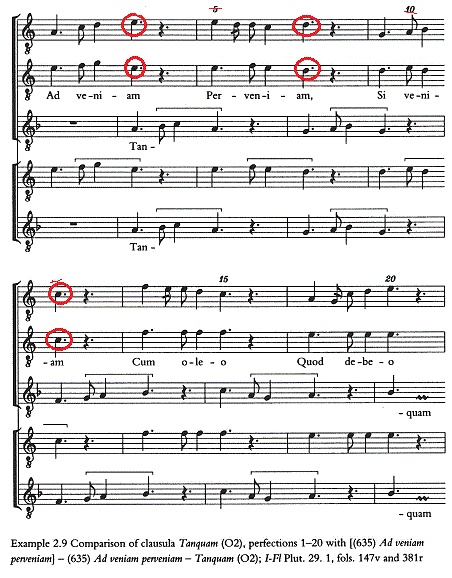 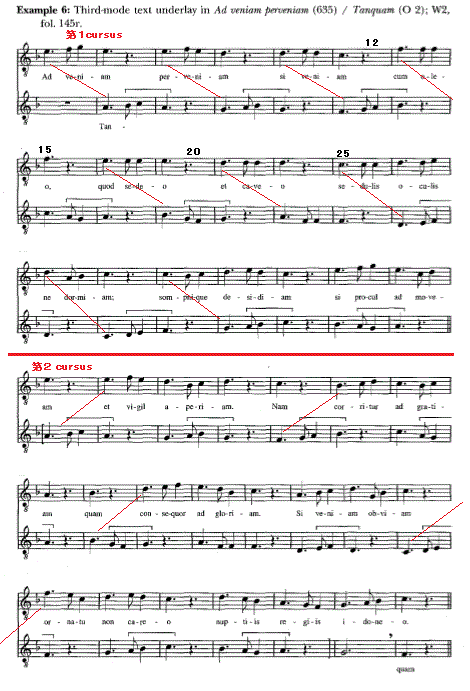 �����N���E�Y������ɂ����Q�����e�b�g �@The opposition between one large phrase, unbroken by any cadence, and the neat asymmetry of the rest of the piece is a direct result of the exchange of voices in the first section and the coupling of voice-exchange with short phrases in the second. The very strict alternation of voices in perfections l�|25 is underpinned by two sequences. Strictly speaking, the first of these involves the tenor (perfections 3-10) and the duplum (perfections 5-12). But the contrapuntal sequence that lies behind it is constructed out of �� chain of three descending parallel-fifth progressions. They are placed at the beginnings of perfections 3�C 7 and 11. These relationships are mapped out in Example 2.10. �@�傫�ȃt���[�Y�i�J�f���c�ŕ��f����Ȃ��j�ƍ�i�̎c��̔�Ώ̐��Ƃ̑Η��́A��P�Z�N�V�����ɂ����鐺�������̒��ڂ̌��ʂƁA��Q�Z�N�V�����ɂ�����Z���t���[�Y�̐��������̌����ł���Bperfections l�|25�ɂ����鐺���̔��Ɍ����Ȍ��́A��̃V�[�P���X�Ŏx�����Ă���B�����Ɍ����A�����̍ŏ��̃Z�N�V�����́Atenor (perfections 3-10)��duplum(perfections 5-12)���܂�ł���B�������A���̔w��ɂ���Έʖ@�I�V�[�P���X�́A���~����R�̕��s�ܓx�i�s�̂Ȃ���ō���Ă���B�����͂��ꂼ��perfections 3�C 7 and 11����J�n����Ă���B���������W�́A Example 2.10�ɂ����Đ�������Ă���B 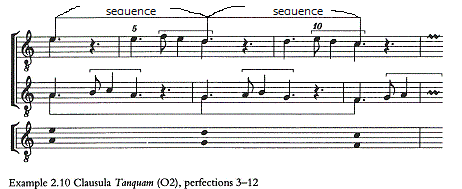 This sequence is followed by another. Its structure parallels the first but in �� more complicated way. Example 2.11 shows these relationships. Again, there are melodic sequences in the duplum: perfections 13-16, 17-20, 21-4 and (modified) 25-7� These are mirrored in the tenor: perfections 15-18, 19-22 and 23-6. The single change in pitch (arrowed) is the original melodic profile of the chant that the composer chose not to modify. The composer of the clausula creates �� contrapuntal structure spanning perfections 13-27 that is more exhaustively sequential. The beamed notes at the top of the upper stave and at the bottom of the lower one indicate the overall progression in parallel fifths that governs this section. The second layer of beamed notes indicates �� subordinate progression of parallel fourths. The ways in which these two sets of parallel motions interact sequentially are outlined in unstemmed noteheads at the bottom of the graph. Both types of sequence �| the melodic and the contrapuntal �| will be seen to be of significance in the process both of adding text and of composing a third voice. ���̃V�[�P���X�̌�ɕʂ̃V�[�P���X�������B���̍\���͑�P�Z�N�V�����ɕ��s���Ă��邪�A��������蕡�G�ȕ��@������Ă���B Example 2.11 �����������W�������B�ēx�Aduplum�ɂ����Đ����̃V�[�P���X�́Aperfections 13-16, 17-20, 21-4 and (modified) 25-7�ɂ����Č�����B������perfections 15-18, 19-22 and 23-6�Ƒ���tenor�̖͕�ł���B����������̕ω��́A��Ȏ҂���������f�B�t�@�C���邱�Ƃ�I�Ȃ������`�����g�̂��Ƃ��Ƃ̐����ɂ�����̂ł����i�j�B�N���E�Y���̍�Ȏ҂́A���O��I�ɃV�[�P���X�I��perfections 13-27�͈̔͂̑Έʖ@�I�\����n�삵�Ă���B��̕��\�̏��Ɖ��̕��\�̒��ɂ���beamed note�́A���̃Z�N�V�������x�z���镽�s�ܓx�̑S�̂̐i�s�������Ă���Bbeamed note�̑�Qlayer�́A���s�S�x�̐i�s�������Ă���B�����ƑΈʖ@�́A�̎����������R������Ȃ����肷��ߒ��ɂ����ďd�v���������Ă���B ���G���Ƃ̃v���C���`�����g������ƁA���̕����̓~���ɂȂ��Ă��邪�E�E�E 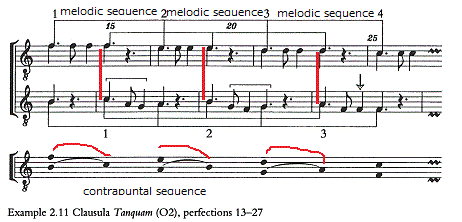 �@�@The poem added to this ��������s��la is as follows: �@�@�@�@�@�@�@�@�@�@�@�@�@�@�@�@�@�@Ad veniam �@�@�@�@�@�@�@�@�@�@�@�@�@�@�@�@�@�@Perveniam, �@�@�@�@�@�@�@�@�@�@�@�@�@�@�@�@�@�@Si veniam �@�@�@�@�@�@�@�@�@�@�@�@�@�@�@�@�@�@Cum oleo �@�@�@�@�@�@�@�@�@�@�@�@�@�@�@�@�@�@Quod debeo �@�@�@�@�@�@�@�@�@�@�@�@�@�@�@�@�@�@Et caveo �@�@�@�@�@�@�@�@�@�@�@�@�@�@�@�@�@�@Sedulis �@�@�@�@�@�@�@�@�@�@�@�@�@�@�@�@�@�@Oculis �@�@�@�@�@�@�@�@�@�@�@�@�@�@�@�@�@�@�m�� dormiam �@�@�@�@�@�@�@�@�@�@�@�@�@�@�@�@�@�@Sompnique desidiam �@�@�@�@�@�@�@�@�@�@�@�@�@�@�@�@�@�@Si procul admoveam �@�@�@�@�@�@�@�@�@�@�@�@�@�@�@�@�@�@Ut vigil aperiam; �@�@�@�@�@�@�@�@�@�@�@�@�@�@�@�@�@�@Nam �@�@�@�@�@�@�@�@�@�@�@�@�@�@�@�@�@�@Sic itur ad gloriam, �@�@�@�@�@�@�@�@�@�@�@�@�@�@�@�@�@�@Quam �@�@�@�@�@�@�@�@�@�@�@�@�@�@�@�@�@�@Consequar per gratiam; �@�@�@�@�@�@�@�@�@�@�@�@�@�@�@�@�@�@Si veniam �@�@�@�@�@�@�@�@�@�@�@�@�@�@�@�@�@�@Obviam �@�@�@�@�@�@�@�@�@�@�@�@�@�@�@�@�@�@Ornatu non careo �@�@�@�@�@�@�@�@�@�@�@�@�@�@�@�@�@�@Nuptiis regiis idoneo. �@Although it does not trope any words of the tenor text, the poem makes �� clear reference in its recurrent use of -am rhymes, and also in the symbolism adopted by the first and final lines of the �o������: �eAd veniam perveniam, si vemam cum oleo' and �eSi veniam obviam ornatu non careo nuptiis regiis ������������'. These lines ��efer to the parable of the wise and foolish virgins and therefore share the imagery of the beginning of the verse: �eTanquam sponsus Dominus procedens de thalamo suo et ��xivit'. In both the responsory verse (explicitly) and the motet text (implicitly) Christ is symbolised ��s the bridegroom. �@tenor�̉̎��̂ǂ̌��t��tropes�����Ă͂��Ȃ����A���̕��́A�J��Ԃ��g����-am�̉��C�ƁA�����Ă܂��A�eAd veniam perveniam, si vemam cum oleo' �� �eSi veniam obviam ornatu non careo nuptiis regiis ������������'�Ƃ����A�ŏ��ƍŌ�̎��̍s�ō̗p���ꂽ�V���{���Y���ɂ����āA���炩�Ȍ��y�����Ă���B���������s�́A�����������ȏ����̋��b�Ɍ��y���A����䂦�ɁAverse�eTanquam sponsus Dominus procedens de thalamo suo et ��xivit'�̍ŏ���imagenary�����L����Bresponsory verse�i�����ȁj�ƃ��e�b�g�̎��i�B���ꂽ�j�ɂ����āA�L���X�g���C�G�X�́A�Ԗ��Ƃ��ďے�����Ă���B �@The short phrases of the duplum result in short lin��s of poetry. The opening six musical phrases, fo�� example, all of four perfections duration in Mode Ill, giv�� rise t�� lines of four syllables each. The sense of the poem consistently overlaps the division of these phrases. In fact, the first major articulation of the sense of the poem comes over half way through, after the line �e�tt vigil aperiam'. duplum�̒Z���t���[�Y���A���̒Z���s�̌��ʂƂȂ��Ă���B�ŏ��̂U�̉��y�t���[�Y�́A���Ƃ��A�Sperfection���ׂ�����R���[�h�ɂȂ��Ă��邪�A���ꂼ��4�̉��߂̍s��������B���I���o�́A��ɂ��������t���[�Y�̕������d�����Ă���B���ہA���I���o�̍ŏ��̎�v���߂́A�e�tt vigil aperiam'�̍s�̌�A�r���܂ł���Ă���B �@In the discussion of Doceas hac die�Cwe saw how a single rhyme dominates the poem, and how individual pairs of rhymes ��lternate with a single overriding line. Here, in Ad veniam perveniam, we can see -am rhymes alternating with one other rhyme: -eo. These two rhymes dominate most of the poem. It is difficult to envisage this simply as a by-product of composing �� new text to �� pre-existent clausula. Such a procedure might enable the composer to maintain �� ������sp of the rhyme of the tenor text without exhausting -am rhymes. In this case, there is such a wealth of words ending -am that it hardly seems a problem. �@�O�y�[�W�̃��e�b�gDoceas hac die�̋c�_�ɂ����āA��X�͂����ɂЂƂ̉C�����S�̂��x�z���邩�������B�����Ă����ɉC�̌X�̃y�A���ЂƂ̍s�̏��z���ƂƂ��Ɍ��݂Ɍ�������邩�A�������B�����AAd veniam perveniam�ɂ����ẮA��X��-am�̉C��-eo�̉C�ƌ��ƌ�シ��l�q�����邱�Ƃ��ł���B�����̂ӂ��̉C�́A���̑啔�����x�z����B�\�ߑ��݂��Ă����N���E�Y���ɑ���V���ȉ̎��Â��̕��Y���Ƃ��Ă����P���ɑz�N���邱�Ƃ͍���Ȃ��Ƃł���B���������v���Z�X�́A��Ȏ҂����ɁA-am�̉C���₷���ƂȂ�tenor�̎��̉C�̔c�����ێ������邱�Ƃ��\�ɂ���B���̃P�[�X�ɂ����Ă��A�قƂ�ǖ��ɂȂ�Ȃ��悤��-am�ŏI��錾�t�̖L�x��������B �@The first change of rhyme in the poem reflects the sequential structure of the source clausula. The first three rhymes are -am. The second three lines use the first new rhyme. The change quite clearly matches the change in the first two sequences illustrated in Examples 2.10 and 2.11: -am for perfections 3-12 and -eo for 13-27� ���ɂ�����C�̍ŏ��̕ω��́A�\�[�X�N���E�Y���̃V�[�P���X�I�\���f���Ă���B�ŏ��̂R�̉C��-am�ł���B���̂R�̍s�͍ŏ��̐V�����C���g���B���̕ω���Examples 2.10��2.11�Ő�������Ă���ŏ��̓�̃V�[�P���X�ɂ�����ω��ɓK�����Ă���B-am for perfections 3-12 and -eo for 13-27�B �@The motet poem on its own seems very modest. When the constraints of rhyme, musical phrase and rhythm are taken into account, however, it is �� very impressive undertaking indeed, and contrasts with the compromises that the composer is required to make in the creation ���� the triplum� �@���e�b�g�̎��͂��ꎩ�g�A���ɍT���߂Ɍ�����B�C�≹�y�t���[�Y�A���Y���̐��l������鎞�A�������Ȃ���A����͔��Ɉ�ۓI�Ɏ����悤�ɂȂ�A��Ȏ҂�triplum��n�삷�邤���v�������Ë��Ƃ͑ΏƓI�ɂȂ�B �@�@Although the poetic text reflects some aspects of the structure of the clausula, the�@added triplum adopts �� rather different position. In the first of the two sequences graphed in Example 2.10 the melodic sequence is abandoned, but the contrapuntal�@sequence is duplicated in the descending e�C d and c in perfections 3�C 7 and 11. This may be compared with the upper part of the contrapuntal summary in unstemmed noteheads at the bottom of Example 2.10. However, in the second sequence, the composer of the new triplum makes no attempt whatsoever to make his contribution correspond melodically with the clausula. Example 2.12 is �� contrapuntal summary of perfections 13-27 of the three-part version of the piece. The contrapuntal sequence is enhanced ��y octave duplications to the G8�\5 and the F8�\5 sonorities. The rest of the voice-part duplicates pitches already present in the contrapuntal structure. �@���̃e�L�X�g�̓N���E�Y���̍\���̂������̑��ʂf���Ă��邪�A�ォ�珑��������ꂽtriplum�́A�ނ���قȂ����ʒu���m�ۂ���BExample 2.10�Ɏ����ꂽ�ӂ��̃V�[�P���X�̂����̍ŏ��ɂ����āA�itriplum�́j�����f�B�̃V�[�P���X�͎̂ċ����Ă���B�������A�Έʖ@�I�V�[�P���X�͉��~����~�A���A�h���iperfections 3�C 7 and 11�j�ɂ������A�d���ƂȂ��Ă����iExample 2.�X�j�B�������Ȃ���A��Q�V�[�P���X�ɂ����ẮA�V����triplum�̍�Ȏ҂́A�N���E�Y���ɑ��āA����ɑ�������悤�Ȑ��������悤�Ȏ��݂͍s���Ă��Ȃ��BExample 2.12�́A���̍�i�ɂ�����R���o�[�W������perfections 13-27���u�Έʖ@�I�܂Ƃ߁v�ł���B���̑Έʖ@�I�V�[�P���X�͏d���ŁA�I�N�^�[�u���߂��Ă���B�����̎c�镔���͑Έʖ@�I�\���ɂ����āA���łɑ��݂��鉹���̏d�����Ă���B  The new triplum adds significant new sonorities to the contrapuntal vocabulary of the clausula. The intervals between duplum and tenor fo������ at the beginning of perfections are unisons, fourths, fifths, octaves and �� single third. Sometimes, the new triplum simply creates sonorities existing elsewhere in the piece: fo�� example, adding an upper or lower fifth t�� �� unison. Adding a third to �� unison creates an interval that is only present once in the original clausula. The original third in the clausula is left untouched by simply repeating the duplum pitch. We have already seen the duplication of an upper octave to create an 8�\5 sonority in the second sequence at the beginning of the piece. Octaves are also enriched by the addition of a fifth to create the same configuration� �V����triplum�́A�N���E�Y���̑Έʖ@�I��b�ɑ��āA�V�����d���sonority��t�������Ă���Bperfection�̍ŏ���duplum��tenor�̉����́A���j�]���A�l�x�A�ܓx�A�I�N�^�[�u�A�����Ĉꂩ���݂̂R�x�ł���B�V����triplu���͒P���ɁA��i�̕ʂ̏ꏊ�ɑ��݂��Ă���sonority��n�����Ă���B���Ƃ��A���j�]���ɑ��āA�ォ�����Ɍܓx��t��������A�Ƃ�����ł���B���j�]���ɑ��ĎO�x�������邱�Ƃ́A�I���W�i���ȃN���E�Y���ɗB�ꑶ�݂��Ă���C���^�[�o����n�����邱�ƂɂȂ�B�N���E�Y���ɂ���I���W�i���ȎO�x�́Aduplum�̉��̒P���ȌJ��Ԃ��ɂ��A������Ŏc���ꂽ�܂܂ɂȂ��Ă���B�����͂��łɁA��i�ŏ��̑��V�[�P���X�ɂ����āA�W-�T��sonority��������I�N�^�[�u�̏d���������B�I�N�^�[�u�́A�����\�������ܓx�̕t���ɂ���Ă��L���ɂȂ�̂ł���B �@The most far-reaching contrapuntal change brought about by the addition of the triplum is the creation of 5�\3 sonorities, by adding a third to �� pre-existent fifth. There are three such 5-3s in the piece, and two of them are placed just before and just after (two perfections in each case) the exact centre of the piece. This is the point at which the second tenor cursus begins. In this way, the triplum brings out �� structural feature of the clausula that was avoided in the phrase-structure of the duplum of the original clausula. In contrast to the duplication of pre-existent pitches to create 8�|5 sonorities, which enhance texturally with the duplication of pitches, these 5-3s add a striking new harmonic dimension to the piece.�@They are used with powerful structural effect. �@triplum�̕t���ɂ���Ă����炳�������Ƃ��L�͂ȑΈʖ@�I�e���́A�T-�Rsonority�̑n���ł���B���Ƃ��Ƒ��݂��Ă����ܓx�ɎO�x��������̂ł���B���̍�i�ɂ͎O�����̂T�|�R�p�^�[����������B�����̂����̓�́A��i�̂ǐ^�̂��傤�ǑO�ƌ�ł���B������tenor�̓�Ԗڂ�cursus���n�܂�Ƃ���ł���B���̂悤�ɂ���triplum�́A�I���W�i���ȃN���E�Y����duplum�̃t���[�Y�\���ł͔������Ă����N���E�Y���̍\���I�����������o���B���̏d���ƂƂ��ɉ̎����ɂ����č��߂�ꂽ�W-�Tsonority��n���������Ƃ��Ƒ��݂������̏d���Ƃ͑ΏƓI�ɁA���������T-�R�\���́A���ڂ��ׂ��V�����n�[���j�[�̎�������i�ɉ������̂ł���B�����̓p���t���ȍ\���I���ʂ������炵���̂ł���B �@Creating a conductus-motet out of a pre-existent three-part clausula caused problems when the clausula chosen was not built up out of triplum and duplum phrases of the same length. Deciding which three-part clausula to turn into �� motet was thus of paramount importance, even though some further modification would occasionally be required. In �� three-part motet with separate triplum and motetus voices, each with its own t����t�C there is no necessity for simultaneous cadences. The entire repertory of three-part clausulae is readily available for this type of treatment. �@������3���N���E�Y��������conductus-motet�̍쐬�́A�I�����ꂽ�N���E�Y��������������triplum��duplum�̃t���[�Y�������Ȃ��������ɖ��ɂȂ����B�R���N���E�Y�������e�b�g�ɂȂ邱�Ƃւ̌���͂���䂦�ɂ���߂ďd�v�Ȃ��Ƃł���A����Ȃ�ω������ɋ��߂�ꂽ�Ƃ��Ă��A�����̃J�f���c�̕K�v���͂Ȃ��B�R���N���E�Y���̑S�̂̃��p�[�g���[�́A���������戵���ɂ͗e�Ղɖ��ɗ��B �@Problems do arise, however, in �� piece that exemplifies the move f��om three-part clausula to double motet (�� three-part motet with separate texts fo�� the two upper voices, in �k��d��ig's parlance): (221) Salve salus hominum �\ (222) O radians stella-Nostrum (Ml4). There are both French and Latin branches to the family of which this motet is �� member. Since the French tradition will be discussed in the ������t chapter, we may here limit our enquiry to the Latin double motet.11 11�@Anderson believed that the French versions, both in three and in four parts, prefigure the Latin ones: �eThe texts in this version [three-part mot��t with two upper-voice t����ts in Latin] present many indications of being ������tr��facta, for they are Marian and the T[enor]chant is from the Mass ������ no attempt has been made t�� trope the t����t�E�E�E�E The 4 ��t French version in ���k���zCl[ayette] and Mo[ntpeIlier] is representative of the earliest pieces known in this form, yet it betrays none of the crude ����perimentation evident in some of these early 4 pt ����rks�C ������ the added 4th part shows considerable skill. The first motet in the motet fascicules [sic] of Mo ���� its CI version must be very close to W2 3 [the third motet fascicle ofW2 ���Us�������� �X of the manuscript] in time, die Qua[druplum�zperhaps being added by the same composer who wrote the basic 3 ��t source clausula, even if all the parts were ����t written at the same time (1611d.�C1:329-30).'Anderson's ����������nts ������ seriously flawed by the assumption that the absence of tropic reference t�� the tenor in the upper voices implies that �� work is contrafactum, and �� narrow �efilial' view of the reworking of the motet family. �� (221) Salve salus hominum �\ (222) O radians stella-Nostrum (Ml4)�� �@���͂������A3���N���E�Y������_�u�����e�b�g�i��Q�������ʂ̉̎������R�����e�b�g�G�k��d��ig�̗p��j�ւ̓����������i�̒��Ɏ����オ���Ă���B (221) Salve salus hominum �\ (222) O radians stella-Nostrum (Ml4)�ł���B���̃��e�b�g���������Ă���O���[�v�ɂ́A�t�����X��n�ƃ��e����n���n��������B��X�͂����ł̓��e����̂R�����e�b�g�Ɍ����čl���Ă݂���11�B 11 Anderson�́A�t�����X��o�[�W�����́A�R���ł��낤�ƂS���ł��낤�ƁA���e����o�[�W���������O�ɑz�肵�Ă���A�ƐM���Ă����B�u���e����̂Q�����㐺���Ɏ��R�����e�b�g�̉̎���contrafacta�ł��邱�Ƃ��A�����̒���������Ă���B�Ȃ��Ȃ�����͐���}���A�̉̂ł���Atenor chant�̓~�T�R���ł���A�e�L�X�g���g���[�v�X�����鎎�݂��Ȃ���������ł���B�E�E�E�v�@Anderso���̐��́Ateno�����g���[�v�X������Ȃ����Ɓ���i��contrafacta�ł���Ƃ�����������邱�Ƃɂ����āA�d��Ȍ��ׂ�����B �@The importance of Salve salus homimnum lies in the ways in which the two uppervoice t����ts are constructed. Whether there is an intermediary between it and its source clausula (in the �炍�� of one ���� more of the French ����t��ts)�C���� whether It depends directly on the source clausula, is of less than immediate significance. Even t�� speak of a source clausula is, in this case, to make several assumptions that should not go unchallenged. �@���e�b�gSalve salus homimnum�̏d�v���́A�Q�̏㐺���̉̎������ꂽ���@�ɂ���B���̂R�����e�b�g�Ƃ��̃\�[�X�N���E�Y���̊Ԃ̒������̂��������̂��A���邢�̓\�[�X�N���E�Y���ɒ��ڂɈˑ����Ă����̂��A�͂���قǏd��Ȃ��Ƃł͂Ȃ��B�\�[�X�N���E�Y���Ɍ��y���邱�Ƃ́A���̃P�[�X�ɂ����ẮA���ނׂ��ł͂Ȃ��������̉ۑ�𗧂Ă邱�ƂɂȂ�B �@First, there is no single source clausula; there are two. The hypothetical three-part piece is made up out of two two-part ones based on ���� identical tenor pattern. It could be suggested that �� lost three-part clausula was broken up into two by combining each of the upper voices separately with the tenor.12 However, since we no longer have the original three-part piece, it is difficult to judge. Employing two two-part clausulae to create �� three-part one implies a degree of opportunism, not to say luck. So does finding a three-part clausula that will respond to being dismembered into two successful pieces of two-part counterpoint. �ŏ��ɁA�\�[�X�N���E�Y���͒P��ł͂Ȃ��A����ł���A�Ƃ������ƁB���z�I�ȂR����i���A���z�I��tenor�p�^�[�����x�[�X�ɂ��āA�ӂ��̂Q����i��������B����ꂽ�R���N���E�Y�����A�㐺�������ꂼ��tenor�ƕʁX�ɑg�ݍ��킹�邱�Ƃɂ���āA�ӂ��ɕ������ꂽ���Ƃ��������Ă���B�������Ȃ���A��X�͂��͂�I���W�i���ȂR����i�͎����Ă��Ȃ��̂ŁA���f�͓���B�ӂ��̂Q���N���E�Y�����R���̈�̍�i�����グ��Ƃ������Ƃ́A�K�^�ł͂Ȃ��y�ώ�`���Ӗ�����B�����ŁA�Q���̑Έʖ@�̂Q�̐���������i�ɕ������ꂽ���ƂɑΉ�����R���̃N���E�Y���������邱�Ƃ��ł���B �@Second, and more important, we have no evidence that this clausula w��s ever used in any liturgical context. It is preserved uniquely among clausula collections in the Florence manuscript, and is ����t found embedded in organum. It may therefore have been �� notational model, rather than �� source, for the motet. ���ɁA�����炪���d�v�Ȃ��Ƃ����A��X�́A���̃N���E�Y�����������̋V���ɏ]�������e�ł��������Ƃ��ؖ��ł��Ȃ��BF�ʖ{���̃N���E�Y���R���N�V�����ɂ����Ă̂ݕۑ�����Ă��邪�A�I���K�k���ɖ��ߍ��܂ꂽ���̂͌������Ă��Ȃ��B����䂦�ɁA���̃N���E�Y���̓��e�b�g�ɑ���\�[�X�Ƃ������́A�L���@���f���ł������̂�������Ȃ��B �@Example 2.13 gives the first twelve perfections of (221) Salve salus hominum�|(222) O radians Stella �\ Nostrom(M14) superimposed on �� reconstruction of the three-part clausula whose music it shares. �@Example 2.13�́A���̉��y�����L����3���N���E�Y����reconstruction�ɏd�˂�3�����e�b�gSalve salus hominum�|(222) O radians Stella �\ Nostrom(M14) �̍ŏ��̂P�Q��erfection�������B 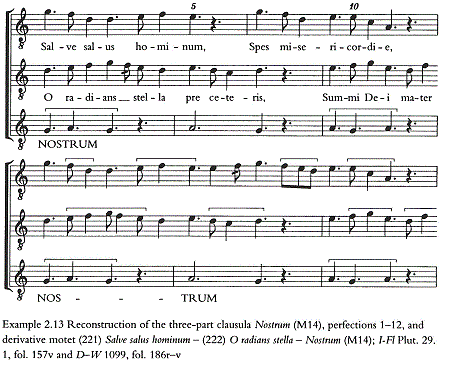 �@The music consists of two upper voices in Mode Ill with �� Mode �u tenor. Mode�Vproduces lines of fo��r�Aseven, ten or thirteen syllables when the text is added.With one exception, an the poetic lines are of this length. The two t����ts are as follows: �@���y�́A��Q���͑�R���[�h�ŁAtenor�͑�T���[�h�Ő��藧���Ă���B�̎���������ƁA��R���[�h�͂S�C�V�C�P�O���邢�͂P�R���߂̍s���邱�ƂɂȂ�B �@�@�@�@�@�@�@�@�@�@�@�@�@�@�@�@�@�@�@�@(Triplum) �@�@�@�@�@�@�@�@�@�@�@�@�@�@�@�@�@�@�@�@Sal-ve sa-lus ho-mi-num,(4,7) �@�@�@�@�@�@�@�@�@�@�@�@�@�@�@�@�@�@�@�@Spes mi-se-ri-cor-die,(13) �@�@�@�@�@�@�@�@�@�@�@�@�@�@�@�@�@�@�@�@Spes venie, �@�@�@�@�@�@�@�@�@�@�@�@�@�@�@�@�@�@�@�@Purgatrix cnminum. �@�@�@�@�@�@�@�@�@�@�@�@�@�@�@�@�@�@�@�@Cecis lumen luminum, �@�@�@�@�@�@�@�@�@�@�@�@�@�@�@�@�@�@�@�@Mater �@�@�@�@�@�@�@�@�@�@�@�@�@�@�@�@�@�@�@�@Prudencie, �@�@�@�@�@�@�@�@�@�@�@�@�@�@�@�@�@�@�@�@Signum vie, �@�@�@�@�@�@�@�@�@�@�@�@�@�@�@�@�@�@�@�@Terminus patrie, �@�@�@�@�@�@�@�@�@�@�@�@�@�@�@�@�@�@�@�@Spes venie, �@�@�@�@�@�@�@�@�@�@�@�@�@�@�@�@�@�@�@�@Nectar, flos glorie, �@�@�@�@�@�@�@�@�@�@�@�@�@�@�@�@�@�@�@�@lusticie �@�@�@�@�@�@�@�@�@�@�@�@�@�@�@�@�@�@�@�@Sol pie, �@�@�@�@�@�@�@�@�@�@�@�@�@�@�@�@�@�@�@�@Clemencie, �@�@�@�@�@�@�@�@�@�@�@�@�@�@�@�@�@�@�@�@Sobrie �@�@�@�@�@�@�@�@�@�@�@�@�@�@�@�@�@�@�@�@Ros, Virgo mundicic. �@�@�@�@�@�@�@�@�@�@�@�@�@�@�@(Motetus) �@�@�@�@�@�@�@�@�@�@�@�@�@�@�@�n ra-di-ans Ste-lla pre ce-te-ris,(4,7,10) �@�@�@�@�@�@�@�@�@�@�@�@�@�@�@Summi Dei mater ��t filia, �@�@�@�@�@�@�@�@�@�@�@�@�@�@�@�d��imia proles degeneris. �@�@�@�@�@�@�@�@�@�@�@�@�@�@�@Tu generis mundi leticia, �@�@�@�@�@�@�@�@�@�@�@�@�@�@�@Tu de via tribulos contens. �@�@�@�@�@�@�@�@�@�@�@�@�@�@�@Spes miseris hominis, �@�@�@�@�@�@�@�@�@�@�@�@�@�@�@Nescia Maria, �@�@�@�@�@�@�@�@�@�@�@�@�@�@�@Dc Uteris �@�@�@�@�@�@�@�@�@�@�@�@�@�@�@Luto nos libera, �@�@�@�@�@�@�@�@�@�@�@�@�@�@�@Regenerans genus �z�� posteris ����������; �@The exception is in the triplum (perfections 27�\30) where the clausula breaks �� pattern of Mode �Vordines with extensio modi for the only time in the piece. This moment is selected for very careful treatment in the motet. It is the only time �� new rhyme is introduced beyond the two presented at the beginning of the triplum poem. The choice of word is entirely appropriate ��s ��ell: �e�l��t����' summarises in �� single substantive t���� entire preoccupation of both upper-voice texts. The passage is given as Example 2.14. �@��O���Aperfections 27�\30��triplum�ł���B�����ł��N���E�Y�����A��R���[�h�̗������i��1�x����extensio modi�̎g�p�ɂ�蒆�f���Ă���B���̏ꏊ�́A���e�b�g���ŁA���Ӑ[����舵���̂��ƂőI��Ă���B�����́Atriplum�̍ŏ����瑶�݂����Q�̉C�����z���A�V�����C�����ꂽ�B��̏ꏊ�ł���B���t�̑I���͂܂������K�ł���B�e�l��t����' �͗��㐺���̑S�̂��\�z��P��̖��O�ɏW�Ă���iExample 2.14�j�B 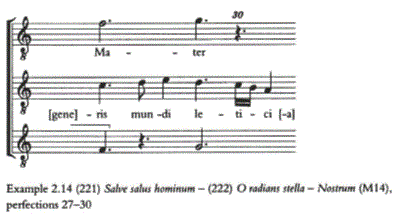 �@What is striking about these two Marian texts is how little they share with each other in terms of imagery. The lack of correlation with the tenor is not uncommon. As will be seen when we turn to the French double motet, the distances that can separate motetus and triplum texts can be very great or very s��all. Here it seems ��s if every effort is being made to separate the two texts. There is no overlap of rhyme: the pairs of rhyme used in each poem are mutually exclusive. �@�����̐��}���A�̂��߂̉̎��Œ��ڂ��ׂ����Ƃ́A�C���[�W�̓_�ŁA�݂��ɂقƂ�Nj��L�������Ȃ����Ƃł���Btenor�Ƃ̘A�ւ̌��@�͒��������Ƃł͂Ȃ��B��X���t�����X��̂R�����e�b�g�ɖڂ�������ƁAmotetus��triplum�̉̎��𗣂����Ƃ��ł��鋗���́A���ɑ傫�����������B����������̉̎������悤�Ƃ���͂������Ă��邩�̂悤�ł���B�C�̏d���͂Ȃ��B���ꂼ��̎��Ŏg����C�̃y�A�́A�݂��ɔr���I�ł���B Invocations are couched in different terms: �eSalve' in the triplum, 'O' in the motetus. Images are different �| �eiusticie sol pie' and �eradians Stella' �| and change independently throughout. The ����ly point of comparison is the use of the word �espes' in the two poems, and the presence of the same ��ormulation twice in the triplum �| �espes venie�f might suggest that the use of the same word in the two texts might not have been the result of specific lexical choice, but the absence of �R sufficiently rich poetic imagination� �h�Ăт����h�͂ӂ��̈�������t�ŕ\�������Btriplum�ɂ����Ă��eSalve'�ŁAmotetus�ɂ����Ă�'O'�ŁB�eiusticie sol pie' �Ɓeradians Stella'�ŁA�C���[�W�͈قȂ�B�����āA�S�̂�ʂ��ēƗ����ĕω�����B��r�̗B��̓_�́A�hspes"�Ƃ������t�̗����ɂ�����g�����ɂ���B�����āAtriplum�ɂ����铯���d�l��2��̎g�p���Ȃ킿�espes venie�f �̎g�p�́A�ӂ��̉̎��̓������t�̎g�p������Ȍ�b�I�I���̌��ʂł������Ƃ������Ƃł͂Ȃ��A�L���Ȏ��̑z���̌��@�ł������Ƃ������Ƃł���B �@There are two procedures used to create �� motet out of �� clausula: the writing of poetry to pre-existent music, and the construction of additional voice-parts t�� enhance two-part clausulae. In the (re) composition ���� music, procedures already found in the clausula are further exploited. The constraints of the phrase-patterns of the host clausula create �� style of poetry that exploits curious irregular line-length. This is not ������y ���� important and consistent feature of early motets but continues to have �� significance into the rest of the century. The unte��ted clausula retains its influence on the poetic style of Latin and French motet texts long after its music ceases to provide the source for newly composed works. �@�N���E�Y�����烂�e�b�g��n������ɂ������ẮA��ʂ�̃v���Z�X�����݂���B��́A���Ƃ��Ƒ��݂��Ă������y�Ɏ������邱�ƁA������́A�Q���̃N���E�Y�������߂邽�߂ɂ����ꐺ����t�����������Ƃł���B���y�̍쐬�ɂ����āA�N���E�Y���ɂ����Č���ꂽ�v���Z�X�͂���S�I�ł������B���̃N���E�Y���̃t���[�Y�p�^�[���̗}���́A�s�K���Ȓ����̍s�𑣐i���鎍�̌`����n�����邱�Ƃɂ���B������������e�b�g���d�v����т������������ł͂Ȃ��A�P�R���I�̎c��ɑ���d�v�������������邱�Ƃł�����B�̎��̂Ȃ��N���E�Y���́A���̉��y���V���ɍ��ꂽ�ȂɃ\�[�X����������̂���߂���������ԁA���e����ƃt�����X�ꃂ�e�b�g�̉̎��̎��̌`���ɑ��A���̉��y�����̉e����ێ����Ă���̂ł���B |